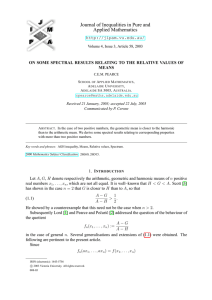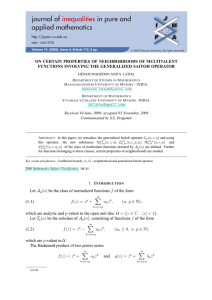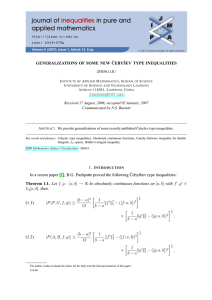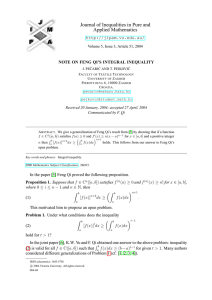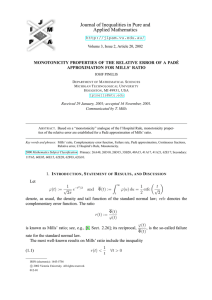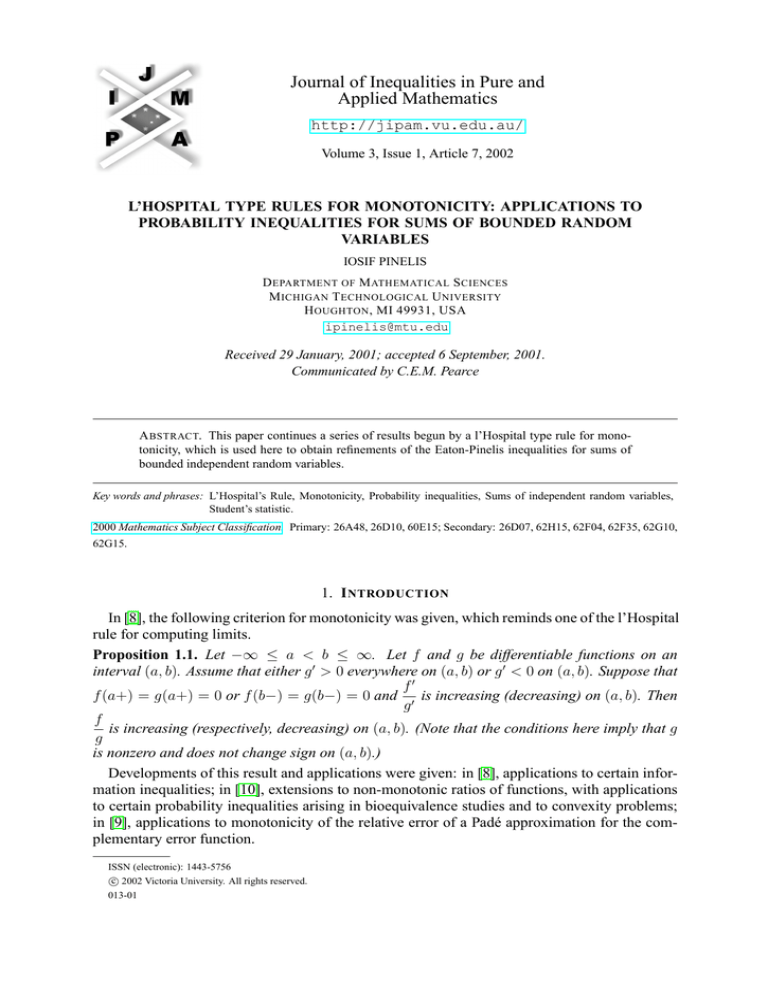
Journal of Inequalities in Pure and
Applied Mathematics
http://jipam.vu.edu.au/
Volume 3, Issue 1, Article 7, 2002
L’HOSPITAL TYPE RULES FOR MONOTONICITY: APPLICATIONS TO
PROBABILITY INEQUALITIES FOR SUMS OF BOUNDED RANDOM
VARIABLES
IOSIF PINELIS
D EPARTMENT OF M ATHEMATICAL S CIENCES
M ICHIGAN T ECHNOLOGICAL U NIVERSITY
H OUGHTON , MI 49931, USA
ipinelis@mtu.edu
Received 29 January, 2001; accepted 6 September, 2001.
Communicated by C.E.M. Pearce
A BSTRACT. This paper continues a series of results begun by a l’Hospital type rule for monotonicity, which is used here to obtain refinements of the Eaton-Pinelis inequalities for sums of
bounded independent random variables.
Key words and phrases: L’Hospital’s Rule, Monotonicity, Probability inequalities, Sums of independent random variables,
Student’s statistic.
2000 Mathematics Subject Classification. Primary: 26A48, 26D10, 60E15; Secondary: 26D07, 62H15, 62F04, 62F35, 62G10,
62G15.
1. I NTRODUCTION
In [8], the following criterion for monotonicity was given, which reminds one of the l’Hospital
rule for computing limits.
Proposition 1.1. Let −∞ ≤ a < b ≤ ∞. Let f and g be differentiable functions on an
interval (a, b). Assume that either g 0 > 0 everywhere on (a, b) or g 0 < 0 on (a, b). Suppose that
f0
f (a+) = g(a+) = 0 or f (b−) = g(b−) = 0 and 0 is increasing (decreasing) on (a, b). Then
g
f
is increasing (respectively, decreasing) on (a, b). (Note that the conditions here imply that g
g
is nonzero and does not change sign on (a, b).)
Developments of this result and applications were given: in [8], applications to certain information inequalities; in [10], extensions to non-monotonic ratios of functions, with applications
to certain probability inequalities arising in bioequivalence studies and to convexity problems;
in [9], applications to monotonicity of the relative error of a Padé approximation for the complementary error function.
ISSN (electronic): 1443-5756
c 2002 Victoria University. All rights reserved.
013-01
2
I OSIF P INELIS
Here we shall consider further applications, to probability inequalities, concerning the Student t statistic.
Let η1 , . . . , ηn be independent zero-mean random variables such that P( |ηi | ≤ 1) = 1 for all
i, and let a1 , . . . , an be any real numbers such that a21 + · · · + a2n = 1. Let ν stand for a standard
normal random variable.
In [3] and [4], a multivariate version of the following inequality was given:
(1.1)
P (|a1 η1 + · · · + an ηn | ≥ u) < c · P (|ν| ≥ u)
∀u ≥ 0,
where
2e3
c :=
= 4.463 . . . ;
9
cf. Corollary 2.6 in [4] and the comment in the middle of page 359 therein concerning the Hunt
inequality. For subsequent developments, see [5], [6], and [7].
Inequality (1.1) implies a conjecture made by Eaton [2]. In turn, (1.1) was obtained in [4]
based on the inequality
(1.2)
P (|a1 η1 + · · · + an ηn | ≥ u) ≤ Q(u) ∀u ≥ 0,
where
(1.3)
(1.4)
1
Q(u) := min 1, 2 , W (u)
u
if 0 ≤ u ≤ 1,
1
1
=
if 1 ≤ u ≤ µ1 ,
u2
W (u) if u ≥ µ1 ,
r
E |ν|3
2
µ1 :=
= 1.595 . . . ;
2 = 2
π
E |ν|
(
)
E (|ν| − t)3+
: t ∈ (0, u) ;
W (u) := inf
(u − t)3
cf. Lemma 3.5 in [4]. The bound Q(u) possesses a certain optimality property; cf. (3.7) in [4]
and the definition of Qr (u) therein. In [1], Q(u) is denoted by BEP (u), called the Eaton-Pinelis
bound, and tabulated, along with other related bounds; various statistical applications are given
therein.
Let
Z u
1 −u2 /2
ϕ(u) := √ e
, Φ(u) :=
ϕ(s) ds, and Φ(u) := 1 − Φ(u)
2π
−∞
denote, as usual, the density, distribution function, and tail function of the standard normal law.
It follows from [4] (cf. Lemma 3.6 therein) that the ratio
(1.5)
r(u) :=
Q(u)
Q(u)
=
,
c · P (|ν| ≥ u)
c · 2Φ(u)
u ≥ 0,
of the upper bounds in (1.2) and (1.1) is less than 1 for all u ≥ 0, so that (1.2) indeed implies
(1.1). Moreover, it was shown in [4] that r(u) → 1 as u → ∞; cf. Proposition A.2 therein.
Other methods of obtaining (1.1) are given in [5] and [6].
In Section 2 of this paper, we shall present monotonicity properties of the ratio r, from which
it follows, once again, that
(1.6)
J. Inequal. Pure and Appl. Math., 3(1) Art. 7, 2002
r<1
on
(0, ∞).
http://jipam.vu.edu.au/
L’H OSPITAL RULES AND BOUNDED RANDOM VARIABLES
3
Combining the bounds (1.1) and (1.2) and taking (1.3) into account, one has the following
improvement of the upper bound provided by (1.1):
1
P (|a1 η1 + · · · + an ηn | ≥ u) ≤ V (u) := min 1, 2 , c · P (|ν| ≥ u)
u
(1.7)
∀u ≥ 0.
Monotonicity properties of the ratio
R :=
(1.8)
Q
V
of the upper bounds in (1.2) and (1.7) will be studied in Section 3.
Our approach is based on Proposition 1.1. Mainly, we follow here lines of [3].
2. M ONOTONOCITY P ROPERTIES OF THE R ATIO r
GIVEN BY
(1.5)
Theorem 2.1.
1. There is a unique solution to the equation 2Φ(d) = d · ϕ(d) for d ∈ (1, µ1 ); in fact,
d = 1.190 . . . .
2. The ratio r is
1
1
(a) increasing on [0, 1] from r(0) = = 0.224 . . . to r(1) =
= 0.706 . . .;
c
c · 2Φ(1)
1
d2
(b) decreasing on [1, d] from r(1) = 0.706 . . . to r(d) =
= 0.675 . . .;
c · 2Φ(d)
(c) increasing on [d, ∞) from r(d) = 0.675 . . . to r(∞) = 1.
Proof.
1. Consider the function
h(u) := 2Φ(u) − uϕ(u).
One has h(1) = 0.07 . . . > 0, h(µ1 ) = −0.06
. . . < 0, and h0 (u) = (u2 − 3)ϕ(u).
√
Hence, h0 (u) < 0 for u ∈ [1, µ1 ], since µ1 < 3. This implies part 1 of the theorem.
2.
(a) Part 2(a) of the theorem is immediate from (1.5) and (1.4).
(b) For u > 0, one has
d
u2 Φ(u) = uh(u),
du
where h is the function considered in the proof of part 1 of the theorem. Since
1
h > 0 on [1, d) and r(u) =
for u ∈ [1, µ1 ], part 2(b) now follows.
2
2cu Φ(u)
(c) Since h < 0 on (d, µ1 ], it also follows from above that r is increasing on [d, µ1 ]. It
remains to show that r is increasing on [µ1 , ∞). This is the main part of the proof,
J. Inequal. Pure and Appl. Math., 3(1) Art. 7, 2002
http://jipam.vu.edu.au/
4
I OSIF P INELIS
and it requires some notation and facts from [4]. Let
1
C := R ∞ −s2 /2 ,
e
ds
Z0 ∞
2
γ(u) :=
(s − u)3 e−s /2 ds,
u
dj γ(u)
γ (j) (u) :=
γ (0) := γ ,
j
du
3γ(t)
µ(t) := t − 0 ,
γ (t)
γ(t)
F (t, u) := C
, t < u;
(u − t)3
(2.1)
cf. notation on pages 361–363 in [4], in which we presently take r = 1.
Then ∀j ∈ {0, 1, 2, 3, 4, 5}
(2.2)
(2.3)
(2.4)
(−1)j γ (j) > 0
on
(0, ∞),
(−1)j γ (j) (u) = 6uj−4 e−u
γ
(4)
−u2 /2
(u) = 6e
2 /2
(1 + o(1))
and γ
(5)
as
u → ∞,
(u) = −6ue−u
2 /2
;
cf. Lemma 3.3 in [4]. Moreover, it was shown in [4] (see page 363 therein) that on
[0, ∞)
µ0 > 0,
(2.5)
so that the formula
t ↔ u = µ(t)
defines an increasing correspondence between t ≥ 0 and u ≥ µ(0) = µ1 , so that
the inverse map
µ−1 : [µ1 , ∞) → [0, ∞)
is correctly defined and is a bijection. Finally, one has (cf. (3.11) in [4] and (1.4)
and (2.1) above)
(2.6)
∀u ≥ µ1
Q(u) = W (u) = F (t, u) = −
C γ 0 (t)3
;
27 γ(t)2
here and in the rest of this proof, t stands for µ−1 (u) and, equivalently, u for µ(t).
Now equation (2.6) implies
(2.7)
dQ(µ(t))
C γ 0 (t)4
dt
Q0 (u) =
=−
.
dµ(t)
27 γ(t)3
dt
for u ≥ µ1 ; here we used the formula
(2.8)
µ0 (t) =
J. Inequal. Pure and Appl. Math., 3(1) Art. 7, 2002
3γ(t)γ 00 (t) − 2γ 0 (t)2
.
γ 0 (t)2
http://jipam.vu.edu.au/
L’H OSPITAL RULES AND BOUNDED RANDOM VARIABLES
5
Next,
γ 0 (t)µ(t) = tγ 0 (t) − 3γ(t)
Z ∞
2
= −3
t(s − t)2 + (s − t)3 e−s /2 ds
Zt ∞
2
(s − t)2 se−s /2 ds
= −3
Zt ∞
2
= −6
(s − t) e−s /2 ds
t
= −γ 00 (t);
for the fourth of the five equalities here, integration by parts was used. Hence, on
[0, ∞),
µ=−
(2.9)
γ 00
,
γ0
whence
γ 002 − γ 0 γ 000
;
γ 02
µ0 =
this and (2.5) yield
γ 002 − γ 0 γ 000 > 0.
(2.10)
Let (cf. (1.5) and use (2.7))
(2.11)
(2.12)
ρ(u) :=
Q0 (u)
0
c · 2Φ (u)
=
C
γ 0 (t)4
.
54c γ(t)3 ϕ(µ(t))
Using (2.11) and then (2.9) and (2.8), one has
d
µ(t)2
3D(t)2 γ 00 (t)2
d ln ρ(u)
0
=
4 ln |γ (t)| − 3 ln γ(t) +
=−
dt
dt
2
γ(t)γ 0 (t)3
for all t > 0, where
D :=
γ 02
− γ.
γ 00
Further, on (0, ∞),
(2.13)
γ0
D = 002 γ 002 − γ 0 γ 000 < 0,
γ
0
in view of (2.2) and (2.10). On the other hand, it follows from (2.3) that D(t) → 0
as t → ∞. Hence, (2.13) implies that on (0, ∞)
D > 0.
(2.14)
Now (2.12), (2.14), and (2.2) imply that ρ is increasing on (µ1 , ∞). Also, it follows
from (2.6) and (2.3) that Q(u) → 0 as u → ∞; it is obvious that c · 2Φ(u) → 0
as u → ∞. It remains to refer to (1.5), (2.11), Proposition 1.1, and also (for
r(∞) = 1) to Proposition A.2 [4].
J. Inequal. Pure and Appl. Math., 3(1) Art. 7, 2002
http://jipam.vu.edu.au/
6
I OSIF P INELIS
3. M ONOTONOCITY P ROPERTIES OF THE R ATIO R GIVEN BY (1.8)
Theorem 3.1.
1. There is a unique solution to the equation
1
= c · P (|ν| ≥ z)
z2
(3.1)
for z > µ1 ; in fact, z = 1.834 . . . .
2.
if 0 ≤ u ≤ 1,
1
1
V (u) =
if 1 ≤ u ≤ z,
u2
c · P (|ν| ≥ u) if u ≥ z.
(3.2)
3. (a) R = 1 on [0, µ1 ] ;
(b) R is decreasing on [µ1 , z] from R(µ1 ) = 1 to R(z) = 0.820 . . .;
(c) R is increasing on [z, ∞) from R(z) = 0.820 . . . to R(∞) = 1[= r(∞)].
Thus, the upper bound V is quite close to the optimal Eaton-Pinelis bound Q = BEP given
1
by (1.3), exceeding it by a factor of at most
= 1.218 . . . . In addition, V is asymptotic (at
R(z)
∞) to and as universal as Q. On the other hand, V is much more transparent and tractable than
Q.
Proof of Theorem 3.1.
1. Consider the function
λ(u) :=
(3.3)
cP (|ν| ≥ u)
= 2cu2 Φ̄(u).
1
u2
Then
λ0 (u) = 2cuh(u),
where h is the same as in the beginning
of the proof of Theorem 2.1 on page 3, with
√
0
2
h (u) = (u − 3)ϕ(u), so √
that 3 is the only root of the equation h0 (u) = 0. Since
h(µ1 ) = −0.06 . . . < 0, h( 3) = −0.07 . . . < 0, and h(∞) = 0, it follows that h < 0
˙ and then so is λ0 . Hence, λ is decreasing on [µ1 , ∞)˙ from λ(µ1 ) = 1.2 . . .
on [µ1 , ∞),
to λ(∞) = 0. Now part 1 of the theorem follows.
2. It also follows from the above that λ ≥ 1 on [µ1 , z] and λ ≤ 1 on [z, ∞). In addition, by
1
(3.3), (1.5), and (1.4), one has λ = on [1, µ1 ], whence λ > 1 on [1, µ1 ] by (1.6). Thus,
r
λ ≥ 1 on [1, z] and λ ≤ 1 on [z, ∞); in particular, cP (|ν| ≥ 1) = λ(1) ≥ 1. Now part
2 of the theorem follows.
3. (a) Part 3(a) of the theorem is immediate from (1.4), (3.2), and the inequality z > µ1 .
(b) Of all the parts of the theorem, part 3(b) is the most difficult to prove. In view of
(3.2), the inequalities z > µ1 > 1, (2.6), and (2.9), one has
(3.4)
R(u) = u2 Q(u) = −
J. Inequal. Pure and Appl. Math., 3(1) Art. 7, 2002
C γ 0 (t)γ 00 (t)2
27 γ(t)2
∀u ∈ [µ1 , z];
http://jipam.vu.edu.au/
L’H OSPITAL RULES AND BOUNDED RANDOM VARIABLES
7
here and to the rest of this proof, t again stands for µ−1 (u) and, equivalently, u for
µ(t). It follows that for all u ∈ [µ1 , z] or, equivalently, for all t ∈ [0, µ−1 (z)],
(3.5)
(3.6)
d
γ 00 (t)
γ 000 (t)
γ 0 (t)
ln R(u) = L(t) := 0
+ 2 00
−2
.
dt
γ (t)
γ (t)
γ(t)
Comparing (2.1) and (2.9), one has for all t > 0
γ 00 (t)
γ(t)
3
=3 0 −t=− t+
,
γ 0 (t)
γ (t)
κ(t)
where
κ(t) := −
(3.7)
γ 0 (t)
;
γ(t)
similarly,
(3.8)
(3.9)
(3.10)
γ 000 (t)
γ 0 (t)
2
=
2
− t = 00
− t;
00
00
γ (t)
γ (t)
γ (t)
γ 0 (t)
this and (3.6) yield
(t2 + 2) κ(t) + 3t
γ 000 (t)
=
−
.
γ 00 (t)
t κ(t) + 3
Now (3.5), (3.6), and (3.9) lead to
N (t, κ(t))
L(t) = −
,
κ(t) (tκ(t) + 3)
where
N (t, k) := −2t k 3 + 3t2 − 2 k 2 + 12t k + 9.
Next, for t > 0,
1 ∂N
2
2
−
=k − t−
k − 2,
6t ∂k
3t
which is a monic quadratic polynomial in k, the product of whose roots is −2,
negative, so that one has k1 (t) < 0 < k2 (t), where k1 (t) and k2 (t) are the two
∂N
∂N
roots. It follows that
> 0 on (0, k2 (t)) and
< 0 on (k2 (t), ∞).
∂k
∂k
Hence, N (t, k) is increasing in k ∈ (0, k2 (t)) and decreasing in k ∈ (k2 (t), ∞).
On the other hand, it follows from (3.7) and (2.2) that
κ(t) > 0 ∀t > 0.
(3.11)
Therefore,
(3.12)
(κ(t) < κ∗ (t) ∀t > 0) =⇒ ( N (t, κ(t)) > min (N (t, 0), N (t, κ∗ (t)))
∀t > 0 ) ;
at this point, κ∗ may be any function which majorizes κ on (0, ∞).
Let us now show the function κ∗ (t) := t + 2 is such a majorant of κ(t). Toward
this end, introduce
Z
1 ∞
2
(−1)
γ
(t) := −
(s − t)4 e−s /2 ds,
4 t
so that
0
γ (−1) = γ.
J. Inequal. Pure and Appl. Math., 3(1) Art. 7, 2002
http://jipam.vu.edu.au/
8
I OSIF P INELIS
Similarly to (3.6) and (3.8),
(3.13)
κ(t) = −
γ 0 (t)
γ (−1) (t)
= −4
+ t.
γ(t)
γ(t)
Again with γ (0) := γ, one has for t > 0
0
−γ (j−1)
−γ (j)
= (j+1) ∀j ∈ {0, 1, . . .},
0
γ
(γ (j) )
−γ (4) (t)
1
=
is decreasing in t > 0. In addition, (2.3)
(5)
γ (t)
t
implies that γ (j) (t) → 0 as t → ∞, for every j ∈ {−1, 0, 1, . . .}. Using now
−γ (−1)
Proposition 1.1 repeatedly, 5 times, one sees that
is decreasing on (0, ∞),
γ
whence ∀t > 0
√
−γ (−1) (t)
−γ (−1) (0)
3 2π
1
<
=
< .
γ(t)
γ(0)
16
2
This and (3.13) imply that
and, in view of (2.4),
κ(t) < t + 2 ∀t > 0.
Hence, in view of (3.12),
N (t, κ(t)) > min (N (t, 0), N (t, t + 2))
∀t > 0.
2
But N (t, 0) = 9 > 0 and N (t, t + 2) = (t2 − 1) ≥ 0 for all t. Therefore,
N (t, κ(t)) > 0 ∀t > 0. Recalling now (3.5), (3.10) and (3.11), one concludes
that R is decreasing on [µ1 , z]. To compute R(z), use (3.4). Now part 3(b) of the
theorem is proved.
(c) In view of (1.5) and (3.2), one has R = r on [z, ∞). Part 3(c) of the theorem now
follows from part 2(c) of Theorem 2.1 and inequalities d < µ1 < z.
R EFERENCES
[1]
J.-M. DUFOUR And M. HALLIN, Improved Eaton bounds for linear combinations of bounded
random variables, with statistical applications, JASA, 88 (1993), 1026–1033.
[2]
M. EATON, A probability inequality for linear combinations of bounded random variables, Ann.
Stat., 2 (1974), 609–613.
[3]
I. PINELIS, Extremal probabilistic problems and Hotelling’s T 2 test under symmetry condition,
Preprint (1991).
[4]
I. PINELIS, Extremal probabilistic problems and Hotelling’s T 2 test under a symmetry condition.
Ann. Stat., 22 (1994), 357–368.
[5]
I. PINELIS, Optimal tail comparison based on comparison of moments. High dimensional probability (Oberwolfach, 1996), 297–314, Progr. Probab., 43, Birkhäuser, Basel, 1998.
[6]
I. PINELIS, Fractional sums and integrals of r-concave tails and applications to comparison probability inequalities. Advances in stochastic inequalities (Atlanta, GA, 1997), 149–168, Contemp.
Math., 234, Amer. Math. Soc., Providence, RI, 1999.
[7]
I. PINELIS, On exact maximal Khinchine inequalities. High dimensional probability II (University
of Washington, 1999), 49–63, Progr. Probab., 47, Birkhäuser, Boston, 2000.
J. Inequal. Pure and Appl. Math., 3(1) Art. 7, 2002
http://jipam.vu.edu.au/
L’H OSPITAL RULES AND BOUNDED RANDOM VARIABLES
9
[8]
I. PINELIS, L’Hospital type rules for monotonicity, with applications, J. Ineq. Pure & Appl. Math.,
3(1) (2002), Article 5. (http://jipam.vu.edu.au/v3n1/010_01.html).
[9]
I. PINELIS, Monotonicity properties of the relative error of a Padé approximation for Mills’ ratio, J. Ineq. Pure & Appl. Math., 3(2) (2002), Article 20.
(http://jipam.vu.edu.au/v3n2/012_01.html).
[10] I. PINELIS, L’Hospital type rules for oscillation, with applications, J. Ineq. Pure & Appl. Math.,
2(3) (2001), Article 33. (http://jipam.vu.edu.au/v2n3/011_01.html).
J. Inequal. Pure and Appl. Math., 3(1) Art. 7, 2002
http://jipam.vu.edu.au/


